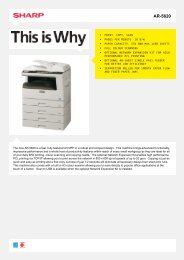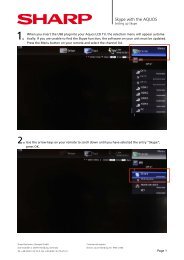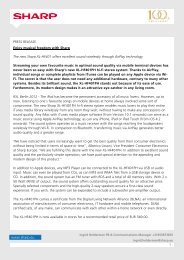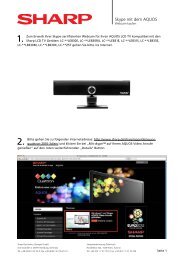Create successful ePaper yourself
Turn your PDF publications into a flip-book with our unique Google optimized e-Paper software.
Before Starting Playback<br />
Using AQUOS LINK<br />
Controlling the Blu-ray disc player<br />
using AQUOS LINK<br />
What is AQUOS LINK?<br />
Using the HDMI CEC (Consumer Electronics<br />
Control), with AQUOS LINK you can interactively<br />
operate this player with your SHARP AQUOS TV.<br />
What you can do with AQUOS LINK<br />
When you connect this player to the LCD TV<br />
compatible with AQUOS LINK using an HDMI cable,<br />
you can perform the functions listed below. (See<br />
page 16 for connecting to the HDMI terminal).<br />
EEAutomatic input select function<br />
When you start playback of this player, the input<br />
selector of the LCD TV will automatically switch to<br />
the LCD TV input terminal connected to the player<br />
and the playback image will appear on the screen,<br />
even if you are watching a TV programme.<br />
EEAutomatic power off function<br />
If you turn off the LCD TV when this player is in stop<br />
mode, the power of this player will be turned off<br />
automatically. (However, when playing back a disc<br />
or other content using this player, the power does<br />
not turn off.)<br />
EEAutomatic power on function<br />
When you switch to the LCD TV input terminal<br />
connected to this player, the power of this player will<br />
be turned on automatically.<br />
EEAQUOS PURE MODE<br />
When you connect this player to an AQUOS LCD<br />
TV compatible with AQUOS LINK and set “AQUOS<br />
LINK” to “Yes” (page 43), images automatically<br />
adjusted to the most suitable image quality for the<br />
AQUOS TV are output from the HDMI OUT terminal<br />
of this player.<br />
NOTE<br />
• In order to make AQUOS LINK available, set “AQUOS<br />
LINK” to “Yes” (See page 43).<br />
Refer to the <strong>Operation</strong> <strong>Manual</strong> of the TV for details<br />
regarding setup.<br />
Using 3D<br />
This sets output of 3D images.<br />
To view 3D images, playback of 3D content (3D <strong>BD</strong><br />
video) is necessary with a 3D compatible TV and 3D<br />
glasses in addition to this player.<br />
Press 3D to change to the 3D mode.<br />
• Each time the button is pressed, the mode switches<br />
between “Auto(3D)” and “2D”.<br />
• The status of the selected mode will be displayed on the<br />
TV screen.<br />
Auto: Video signals are output as 3D when 3D content (3D<br />
<strong>BD</strong> video) is played or as 2D when 2D content is played.<br />
2D: Even if 3D content (3D <strong>BD</strong> video) is played, video<br />
signals are output as 2D at all times.<br />
• This setting (Auto(3D)/2D) can also be performed using<br />
the menu screen (See page 45).<br />
NOTE<br />
• The 3D mode can be switched only when playback is<br />
stopped.<br />
• Depending on the connected TV, the images during<br />
playback may switch to 2D images due to changes in<br />
the resolution, etc. Make sure the 3D image setting is<br />
performed on the TV.<br />
• The 3D images may not be output as set in “HDMI<br />
Video Out”.<br />
• When performing Fast Forward/Reverse, images are<br />
shown in 2D.<br />
CAUTION<br />
• When viewing 3D images, viewing for a long period<br />
of time or lying on your back may cause eye strain<br />
and discomfort. In addition, 3D images may affect the<br />
eyesight of young children/infants, so keep them from<br />
viewing the images.<br />
Playback<br />
23
















